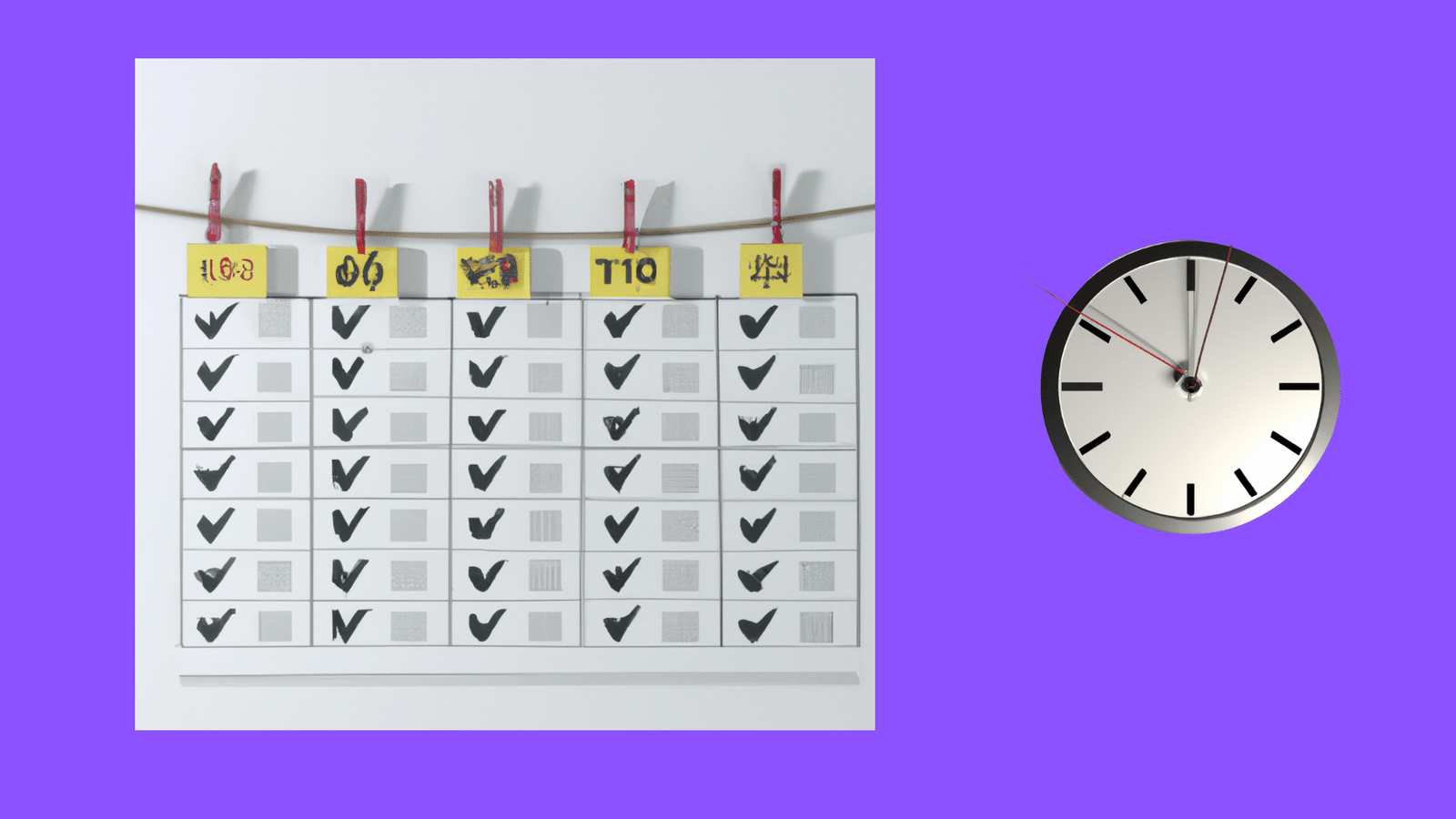The 10-Second Rule
The 10-second rule has emerged as a simple yet effective strategy to combat procrastination and hesitation in various aspects of daily life. This rule, coined by renowned author and motivational speaker Mel Robbins, suggests that when an individual feels the urge to hesitate or delay a task, they should count down from ten and take immediate action upon reaching one. The premise behind the rule is grounded in cognitive science and behavioral psychology, emphasizing that taking swift action can disrupt patterns of doubt and inaction.
Rooted in the idea that hesitation can lead to missed opportunities and increased procrastination, the 10-second rule emphasizes the critical nature of making timely decisions. As our minds often focus on the potential negatives or fears surrounding a choice, the act of counting down serves as a mental reset, prompting a shift towards action rather than indecision. This approach allows individuals to overcome the initial inertia that often accompanies tasks they may find daunting or unappealing.
In essence, the 10-second rule acts as a powerful tool for enhancing productivity. By encouraging immediate action, it capitalizes on the natural inclination to avoid discomfort or uncertainty. Thus, instead of allowing procrastination to hinder progress, individuals can harness the 10-second rule to initiate tasks swiftly and efficiently. The efficacy of this method lies not only in its simplicity but also in its ability to empower individuals to take control of their decisions and reduce the mental load that procrastination typically imposes.
By integrating the 10-second rule into daily routines, individuals can foster a proactive mindset, ultimately leading to greater productivity and achievement of personal goals. In the fast-paced nature of modern life, the ability to act decisively is invaluable, making the 10-second rule an essential tool for anyone seeking to break free from the cycle of hesitation.
Understanding Procrastination
Procrastination is a complex behavioral phenomenon that afflicts many individuals, often manifested as the voluntary delay of an intended action despite an awareness of negative consequences. This postponement is not merely a matter of poor time management; it is deeply rooted in psychological factors. One significant reason for procrastination is the fear of failure. Many individuals avoid tasks that they believe may lead to subpar performance or judgment from others, creating a mental barrier that hinders progress.
Another contributing factor is the feeling of being overwhelmed. When faced with large projects or tasks that seem insurmountable, individuals may become paralyzed by the scope of work required. This overwhelm often leads to avoidance behavior, further delaying necessary action and exacerbating feelings of anxiety and inadequacy. Additionally, perfectionism plays a crucial role in procrastination. The desire to fulfill a high standard can lead to indecision, as individuals may constantly revise or second-guess their work in pursuit of an ideal that may remain unattainable, thus procrastinating the act of completion.
The negative ramifications of procrastination are numerous, significantly impacting productivity and emotional well-being. Chronic procrastinators often experience heightened levels of stress, stemming from the accumulation of tasks and impending deadlines. This stress may compound feelings of inadequacy, leading to a vicious cycle where the act of delaying tasks leads to more significant emotional distress. Understanding the psychological underpinnings of procrastination is essential in developing effective strategies to combat it. By recognizing the various triggers that promote this behavior, individuals can better equip themselves to overcome hesitation, ultimately leading to improved productivity and enhanced quality of life. The subsequent sections will explore practical solutions, including the implementation of methods like the 10-second rule, to address procrastination efficiently.
The Science Behind the 10-Second Rule
The 10-Second Rule is grounded in psychological and neuroscientific principles that elucidate its effectiveness as a rapid response technique for overcoming hesitation. Central to this methodology is the concept of immediate action, which serves to bypass the brain’s inherent risk-averse tendencies. When faced with a decision, the brain often engages in intensive cognitive deliberation, weighing potential outcomes and anxieties associated with inaction. However, research has shown that this deliberative process can lead to paralysis by analysis, where excessive consideration results in procrastination.
Studies on decision-making reveal that shorter intervals for making choices typically yield more decisive behavior. Engaging with the 10-Second Rule encourages individuals to act swiftly—typically within a ten-second window—thereby mitigating the impulse to overthink. Neuroscientifically, this aligns with findings on impulse control that highlight the brain’s tendency to inhibit actions based on perceived risks. By training oneself to respond within a condensed timeframe, individuals can create a pattern of behavior that becomes instinctual, where initiating action is perceived as a norm, rather than an exception.
Moreover, embarking on action, even in small increments, has the potential to generate momentum. The concept of momentum is vital in understanding how initial actions can lead to further tasks being accomplished. The “small wins” paradigm posits that each action taken boosts confidence and reduces anxiety levels. As a result, the act of engaging with the 10-Second Rule not only prompts quick decisions but also lays the groundwork for a more assertive and productive mindset. By consistently applying this technique, one can restructure their approach to challenges, ultimately fostering greater resilience against the urge to procrastinate.
How to Implement the 10-Second Rule
Integrating the 10-second rule into daily life requires mindful observation and practice. The first step is to identify specific scenarios where hesitation typically arises. Common situations may include deciding whether to speak up in a meeting, initiating a workout, or even making a difficult phone call. Acknowledging these moments of indecision is crucial as it lays the groundwork for applying the rule effectively.
Once you have pinpointed situations prone to procrastination, the next step involves developing cues to trigger the 10-second rule. This can be as simple as setting reminders on your phone or placing sticky notes in visible locations. The intention behind these cues is to prompt you to act swiftly before your mind has the chance to overthink or create excuses. For instance, if you often hesitate to exercise, a motivational quote on your bathroom mirror can serve as a gentle nudge to initiate your workout routine.
Practicing the technique through small, manageable actions can significantly enhance your confidence and ability to act quickly. Begin by choosing trivial tasks, such as making your bed or starting on a household chore. The essence of the 10-second rule lies in making a decision and acting on it before your mind starts to dwell on reasons to avoid it. Over time, as you celebrate the small victories by overcoming hesitation, you will find it easier to apply the rule to larger tasks.
There are numerous real-life examples illustrating the effectiveness of this technique. Entrepreneurs often recount how the 10-second rule enabled them to embrace opportunities and forge connections, while individuals seeking personal development have shared stories of instantly committing to healthier habits. This technique is notably adaptable, making it applicable across various life scenarios.
Common Challenges and Solutions
Applying the 10-second rule to overcoming hesitation can encounter several challenges that individuals must navigate. One of the most common obstacles is the natural resistance to immediate action. This resistance often stems from a fear of failure or a tendency to overthink decisions. Individuals may find themselves hesitating as they weigh options, leading to inaction. To counter this, it is essential to remind oneself that the goal is to act quickly and decisively rather than to achieve perfection. Embracing the notion of ‘progress over perfection’ can help alleviate this mental roadblock.
Another significant difficulty with embracing the 10-second rule is the challenge of habit change. Many people are creatures of habit, relying on their established routines that provide comfort and predictability. Shifting away from these pre-existing behaviors can be daunting. Overcoming this requires not just the willingness to act but also the establishment of accountability. Engaging a friend or colleague to practice the rule together can foster a supportive environment that encourages immediate action while providing motivation. Establishing small, manageable goals can also aid in easing the transition into adopting this strategy.
Additionally, distractions frequently hinder individuals from implementing the 10-second rule effectively. In a world filled with notifications and constant stimulation, maintaining focus becomes increasingly challenging. To combat this, creating a conducive workspace, free from distractions, can significantly impact one’s ability to act promptly. Implementing time-blocking strategies where specific tasks are designated for focused periods can also be beneficial. Moreover, utilizing digital tools to limit distractions by turning off notifications during periods of intended action can help individuals adhere to the 10-second rule.
By proactively addressing these challenges through practical strategies, individuals can unlock the full potential of the 10-second rule, fostering a culture of prompt action and decisiveness.
Success Stories: Real-Life Applications
The 10-second rule, a simple yet effective technique for overcoming procrastination, has inspired numerous individuals to break free from hesitation in various facets of their lives. Many have shared their success stories, demonstrating the transformative power of this approach. One notable example is of Sarah, a fitness enthusiast who struggled to maintain her workout routine. For years, she hesitated every time it was time to hit the gym. However, after implementing the 10-second rule, she conditioned herself to count down from ten before deciding whether to go or stay home. This practice not only eliminated her procrastination but also resulted in her achieving significant fitness milestones, such as completing her first half-marathon.
Similarly, Mark, an office manager known for delaying essential tasks, found solace in the 10-second rule. Faced with daunting reports and meetings he dreaded, he adopted this simple technique to foster a more productive work environment. Instead of allowing his mind to dwell on the unpleasant nature of these tasks, he began a countdown before tackling each one. This shift in perspective allowed him to initiate action quickly, reducing both his workload and stress, ultimately leading to recognition as an exemplary employee.
In personal matters, Jamie saw remarkable improvements in decision-making through the application of the 10-second rule. Faced with frequent dilemmas in social settings, she often found herself overthinking her choices, which led to missed opportunities. By practicing a short countdown, she learned to trust her instincts and make swift decisions, whether it was accepting spontaneous invitations or trying new experiences. This newfound confidence significantly enhanced her social life and overall happiness.
These stories showcase that the 10-second rule is not merely a theoretical concept but rather a practical tool that can lead to real, positive change. In both personal and professional domains, individuals have reclaimed their time and peace of mind, proving that often, the smallest adjustments can yield significant results.
Tools and Resources to Enhance Your Practice
Implementing the 10-second rule effectively requires not only dedication but also the right tools and resources to support this practice. In today’s digital age, various applications and platforms can significantly enhance productivity, provide accountability, and encourage immediate action.
One fundamental tool that can be particularly beneficial is productivity apps. Applications such as Todoist and Trello allow users to create lists and set deadlines, enabling a structured approach to tasks. These apps feature reminder functions to encourage immediacy in completing tasks as they arise, thus facilitating the adherence to the 10-second rule.
Using timers can also significantly aid in overcoming hesitation. Tools like the Pomodoro Technique, facilitated by apps such as Focus Keeper, can help users stay focused. By setting short bursts of intense work followed by brief breaks, individuals can create an environment conducive to taking immediate action without the burden of prolonged commitment to a task.
Journaling practices are another valuable resource. Maintaining a daily journal to track activities, feelings, and challenges can cultivate a heightened sense of awareness regarding procrastination triggers. Apps like Day One or a simple physical journal allow users to reflect on their progress and offer a space for accountability, encouraging swift responses to tasks as they arise.
Lastly, community support platforms such as Reddit or Facebook Groups dedicated to productivity can provide peer motivation. Engaging with others who are also practicing the 10-second rule creates an encouraging atmosphere where members can share their struggles and victories, thereby reinforcing the commitment to immediate action.
Utilizing these tools and resources can significantly enhance the practice of the 10-second rule, fostering a proactive mindset and aiding in the fight against procrastination.
Long-Term Benefits of Using the 10-Second Rule
Consistently applying the 10-second rule can yield remarkable long-term benefits across various aspects of daily life. The most immediate advantage is a significant improvement in time management. By breaking the cycle of hesitation, individuals can make quicker decisions and allocate their time more efficiently. This increased productivity leads to a more organized lifestyle where tasks are tackled promptly, reducing the backlog of responsibilities.
Moreover, the 10-second rule cultivates enhanced decision-making skills. Regular practice encourages individuals to evaluate their options more rapidly and trust their instincts. As these decisions become habitual, the mental energy expended on choices diminishes, allowing for a clearer focus on executing tasks rather than deliberating over them. This efficiency not only aids in personal projects but also proves advantageous in professional environments, where timely and sound decision-making is pivotal.
Another significant outcome of using the 10-second rule is an increase in self-confidence. When individuals see the positive consequences of their decisions, it fosters a sense of empowerment. The more they apply this rule, the more they realize their potential to act decisively, which enhances self-esteem and encourages taking on new challenges. Over time, this competence can contribute to personal growth, opening doors to opportunities that may have previously seemed daunting.
Finally, the 10-second rule can help diminish anxiety surrounding various tasks. The mental barrier of overthinking can be a significant obstacle for many. By simply committing to act within 10 seconds, individuals can alleviate the pressure that often accompanies task initiation. This shift allows for a more proactive and less fear-driven approach to responsibilities, ultimately leading to a healthier mindset and a more fulfilling life. The cumulative effect of these benefits is profound, making the 10-second rule a powerful tool for overcoming procrastination and enhancing overall quality of life.
Taking Action Today
In summation, the 10-second rule serves as a powerful method for overcoming hesitation and breaking free from the chains of procrastination. As discussed throughout this article, the essence of the 10-second rule lies in its simplicity and immediacy; it encourages individuals to act swiftly before their minds introduce doubts or distractions. Recognizing that the first step often holds the most weight in any endeavor is crucial. By implementing this technique, you can foster a proactive mindset, leading to notable improvements in productivity and overall life satisfaction.
The practice of applying the 10-second rule is not merely about completing a task; it is about reshaping how we approach challenges. Hesitation can lead to missed opportunities, while swift action enhances confidence and efficiency. By making the conscious choice to act within a ten-second window, you cultivate a habit of decisiveness that will serve you well across various aspects of your life. Whether it is starting a new project, engaging in a conversation, or tackling a daunting task, taking that initial step can result in significant momentum.
As you move forward, I encourage you to reflect on the areas in your own life where hesitation tends to hold you back. Take a moment to identify those instances where the 10-second rule can be applied. Remember, every moment spent in indecision is a moment taken away from potential achievements. By applying this simple yet effective technique, you are not only enhancing your productivity but also improving your overall quality of life. Start today, take the first step, and watch as you move closer to your goals with newfound determination and purpose.









